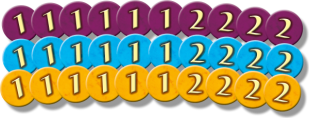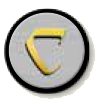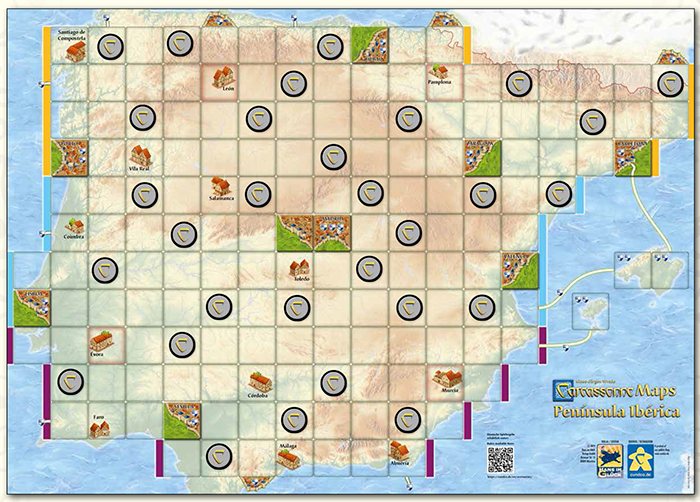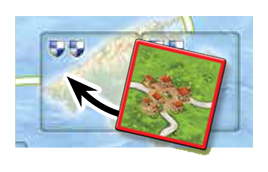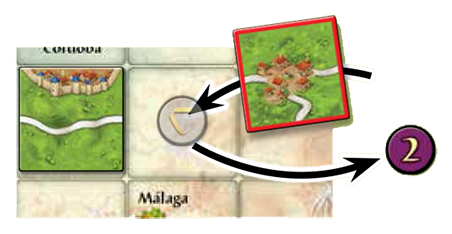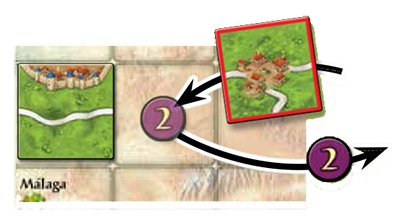Difference between revisions of "Map-Chips Iberian Peninsula/nl"
(Created page with "* '''30 landkaart-fiches''' (10 stuks in elk van de kleuren paars, lichtblauw, en oranje). <div style="margin: 10px 0px 10px 22px;"> {{BeginBlockList|700px}} {{StartBlock|320px}} 309px|frame|none|Carcassonne landkaart-fiches {{EndBlock}} {{StartBlock|120px}} 100px|frame|none|Achterkant landkaart-fiche {{EndBlock}} {{EndBlockList}} </div>") |
(Created page with "512px|frame|none|Start-vakken voor Carcassonne landkaarten - Iberisch schiereiland") |
||
| Line 34: | Line 34: | ||
Use 3 of the 4 available starting-squares (León, Pamplona, Évora and Murcia). | Use 3 of the 4 available starting-squares (León, Pamplona, Évora and Murcia). | ||
[[File:Map-Chips_Iberian_Peninsula_C2_Start-Tiles.png|512px|frame|none|Start- | [[File:Map-Chips_Iberian_Peninsula_C2_Start-Tiles.png|512px|frame|none|Start-vakken voor Carcassonne landkaarten - Iberisch schiereiland]] | ||
Shuffle all '''30 Map-Chips''' face down. Place them evenly distributed on the squares of the map and stick to the following rules: | Shuffle all '''30 Map-Chips''' face down. Place them evenly distributed on the squares of the map and stick to the following rules: | ||
Revision as of 22:35, 7 April 2023
General info and comments
Carcassonne landkaart-fiches werd oorspronkelijk in Template:Year nl uitgebracht door Hans im Glück.
Dit is een mini-uitbreiding met verschillende spelregels voor elke Carcassonne landkaart. In het geval van Carcassonne landkaarten - Iberisch schiereiland (Península Ibérica) kunnen spelers fiches verzamelen en ze als traktaties neerleggen. Spelers die een traktatie vinden krijgen daar punten voor.
Contents
- 30 landkaart-fiches (10 stuks in elk van de kleuren paars, lichtblauw, en oranje).
It is recommended to play with 110–120 tiles, for example with the basic game and the first and second expansions, that is, Exp. 1 - Inns and Cathedrals and Exp. 2 - Traders and Builders.
Rules
Preparation
Use 3 of the 4 available starting-squares (León, Pamplona, Évora and Murcia).
Shuffle all 30 Map-Chips face down. Place them evenly distributed on the squares of the map and stick to the following rules:
- Place the chips face down
- Place only 1 chip per square
- Place no chips on the large city squares or town squares
- Place no chips next to each other vertically or horizontally (only diagonally)
- Place no chips vertically or horizontally adjacent to a used start square or to an open edge of a large city
- Place no chips on the island squares of the Balearic Islands.
Gameplay
1. Placing a tile
Island squares with coats of arms
You can only place tiles on island squares if they have been connected with a ferry route from the mainland (see general rules here). If you place a tile on a square with a coat of arms, you'll score 2 points for each coat of arms immediately.
Collecting chips
If you place a tile on a square with a chip, you take the chip, flip it over and score 1 or 2 points immediately. Then you place the chip again face up on the map respecting the following rules "to place a treat." [1]
Placing a treat
The color of a chip determines the area, that is, the tracks in which you have to place your treat face up:
- Orange chip = top tracks (rows 1 to 4)
- Blue chip = centre tracks (rows 5 to 8)
- Purple chip = bottom tracks (rows 9 to 12)
On one rows of the chosen tracks, you look for a free square without a tile (pre-printed or placed) and place the chip face up on it. [2]
Collecting treats
If you place a tile on a square with a treat (face-up chip), you take the chip and you get twice the number of points shown on the chip (2 or 4 points). [3] Then you take the chip out of the game.
End of the game
Remaining face-up or face-down chips don't give you any more points at the end of the game.
2. Placing a meeple
After having placed a tile, you are allowed to place a meeple according to the general rules.
3. Scoring a feature
The scoring is done as usual.
Tile distribution
Total Tokens: 30
Voetnoten
Kijk op de Pictogrammen pagina voor uitleg over en licensering van de pictogrammen.
- ↑
 The German rules refer to "treats" as "geocaches."
The German rules refer to "treats" as "geocaches."
- ↑
 Note that "free" stresses that the chosen square may not have a chip on it. As indicated in the rules, the chosen square may not have a printed or placed tile on it either. So, it is not allowed to place more than one treat per square.
Note that "free" stresses that the chosen square may not have a chip on it. As indicated in the rules, the chosen square may not have a printed or placed tile on it either. So, it is not allowed to place more than one treat per square.
- ↑
 The original German rules indicated a different amount of points: "you get three times the number of points shown on the chip (3 or 6 points)." This also affected Example 3. The latest rules removed this discrepancy.
The original German rules indicated a different amount of points: "you get three times the number of points shown on the chip (3 or 6 points)." This also affected Example 3. The latest rules removed this discrepancy.
